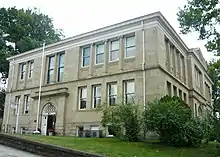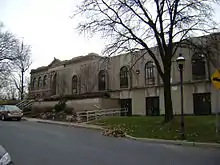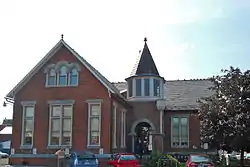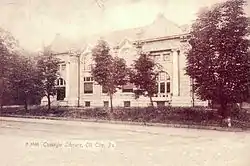List of Carnegie libraries in Pennsylvania
The following list of Carnegie libraries in Pennsylvania provides detailed information on United States Carnegie libraries in Pennsylvania, where 59 public libraries were built from 27 grants (totaling $5,169,587) awarded by the Carnegie Corporation of New York from 1886 to 1917. Notably, Allegheny County, Pennsylvania contains the first Carnegie libraries ever donated by the philanthropist, owing to his personal connection to the Pittsburgh area. Architectural Critic Patricia Lowry calls them "Pittsburgh's most significant cultural export".[1]
Five out of the first seven, six of the first ten, and seven of the first twelve libraries that Carnegie commissioned in America are in Allegheny County. Also, eleven of the first fourteen Carnegie funded libraries to open in America were in Allegheny County. In all, 19 libraries were commissioned in the county and several of them are more than just libraries but are cultural centers as well.
Also among the libraries built were 25 in Philadelphia which are listed separately. In addition to public libraries, academic libraries were built for 9 institutions, more than any other state. These grants totaled $441,000. In addition Carnegie founded two entire colleges in Pittsburgh, Carnegie Institute of Technology and Margaret Morrison College for Women. Both are today part of Carnegie Mellon University.
Key
Building still operating as a library
Building standing, but now serving another purpose
Building no longer standing
Building listed on the National Register of Historic Places
Public libraries
| Library | Locality | Image | Date granted[2] |
Grant amount[2][3] |
Location | Notes | |
|---|---|---|---|---|---|---|---|
| 1 | Allegheny | Allegheny County—North Side of Pittsburgh, formerly known as Allegheny City |  |
1886 | $481,012 | 6 Allegheny Square East | The first Carnegie Library in the US to be commissioned and the second to open. Dedicated by Carnegie and U.S. President Benjamin Harrison on February 20, 1890. Also houses the first Carnegie Hall in the US, which is now used by the New Hazlett Theater. And starting in 2017, the library space is being renovated and being turned into the Museum Lab, which is a part of the Children's Museum across the street, and will open in April 2019. |
| 2 | Beaver Falls | Beaver Falls, Beaver County |  |
Aug 15, 1899 | $50,000 | 1301 7th Ave. | The 20th Carnegie Library in the U.S. to be commissioned. |
| 3 | Braddock | Allegheny County -- Braddock |  |
1887 | $357,782 | 419 Library St. 40°24′07″N 79°51′56″W |
The first Carnegie Library in the US to open and the second to be commissioned. Dedicated by Carnegie and U.S. President Benjamin Harrison on March 30, 1889. Originally, it was not a publicly supported library but was fully funded by the Carnegie Steel Co. and governed by its officials. The first of four such libraries in the US to be fully endowed. An 1893 expansion doubled the size of the building and includes the third Carnegie Music Hall in the US, a Gymnasium, and a swimming pool (currently out of use). |
| 4 | Bradford | Bradford, McKean County |  |
Jan 19, 1900 | $40,000 | 27 Congress St. | Now a restaurant |
| 5 | Butler | Butler, Butler County | May 3, 1917 | $37,000 | 218 N. McKean St. | The last library commissioned by Carnegie in Pennsylvania and among the last in the entire country. Opened 1921; renovated 1966 and 2003 | |
| 6 | Carnegie | Allegheny County -- Carnegie |  |
Apr 26, 1898 | $310,000 | 300 Beechwood Ave. | The seventh Carnegie Library in the USA commissioned and the third to be fully endowed. Opened May 1, 1901. Official name: Andrew Carnegie Free Library. Of the 2,509 libraries built by Andrew Carnegie, it was the only public library granted permission to use both his first and last names. In addition to the library, it includes a 788-seat Music Hall, 140-seat Lecture Hall, Civil War Museum, and a small in-town park.[4] |
| 7 | Connellsville | Connellsville, Fayette County |  |
Apr 22, 1899 | $75,000 | 299 S. Pittsburgh St. | The 13th library in the US to receive a grant. |
| 8 | Corry | Corry, Erie County | .jpg.webp) |
Nov 9, 1916 | $15,000 | 203 N. Center St. | Now a restaurant |
| 9 | Duquesne | Allegheny County -- Duquesne | Jan 23, 1901 | $310,000 | The fourth and final library to be fully endowed. Carnegie had a Steel Mill here. Demolished in June 1968 | ||
| 10 | Easton | Easton, Northampton County |  |
Jul 4, 1901 | $57,500 | 515 Church St. | |
| 11 | Edgewood | Allegheny County -- Edgewood | May 8, 1914 | $12,500 | 1 Pennwood Ave. | C.C. Mellor Memorial Library, opened September 1, 1916. Named for Charles C. Mellor, one of the original trustees, appointed by Andrew Carnegie, of the Carnegie Library of Pittsburgh. | |
| 12 | Hamburg | Hamburg, Berks County |  |
Feb 20, 1903 | $10,000 | 35 N. 3rd St. | |
| 13 | Homestead | Allegheny County -- Munhall |  |
Nov 27, 1896 | $322,067 | 510 E. 10th Ave. | The sixth Carnegie Library in the US to be commissioned and the second to be fully endowed. Opened November 5th, 1898. It was the 7th to open—the Lawrenceville branch of Pittsburgh, commissioned at the same time as its main branch, opened 6 months earlier. Also contains a Carnegie Music Hall, a lecture hall, a gymnasium, a swimming pool, and a bowling alley. |
| 14 | Johnstown | Johnstown, Cambria County | .jpg.webp) |
Mar 9, 1890 | $55,332 | 304 Washington St. | The fourth Carnegie Library commissioned in the US and the first outside of Allegheny County, Pennsylvania. Now the Johnstown Flood Museum. |
| 15 | Mansfield | Mansfield, Tioga County | Mar 29, 1911 | $5,000 | 71 N. Main St. | ||
| 16 | McKeesport | Allegheny County -- McKeesport |  |
Apr 2, 1899 | $50,000 | 1507 Library Ave. | The 12th library in the USA to receive a grant from Carnegie. Opened July 15, 1902. |
| 17 | Midland | Midland, Beaver County |  |
May 8, 1914 | $20,000 | 61 9th St. | |
| 18 | North Bessemer | Allegheny County -- Penn Hills | May 1, 1901 | $20,600 | Demolished in the 1950s | ||
| 19 | Oakmont | Allegheny County -- Oakmont |  |
Jan 24, 1899 | $25,000 | 700 Allegheny River Blvd. | The tenth library in the US to receive a grant. Opened 1901. |
| 20 | Oil City | Oil City, Venango County |  |
Apr 12, 1900 | $44,000 | 2 Central Ave. | |
| 21 | Phoenixville | Phoenixville, Chester County |  |
Mar 9, 1901 | $20,000 | 183 2nd Ave. | |
| 22 | Pittsburgh Main | Allegheny County -- Pittsburgh |  |
Feb 6, 1890 | $1,160,614[5] | 4400 Forbes Ave. | The third Carnegie Library commissioned in the US and the first to have multiple branches. Main library dedicated November 5, 1895, at which time Carnegie announced an additional gift to enlarge the building. The mammoth structure in the Oakland neighborhood of Pittsburgh contains the Main Library, Carnegie Music Hall (the fourth to open in the USA), Carnegie Museum of Natural History, and Carnegie Museum of Art. |
| 23 | Pittsburgh East Liberty | Pittsburgh | Feb 6, 1890 | — | Opened 1905, demolished in the 1960s. In 1967 a new Carnegie library opened at a different location in East Liberty. That structure was renovated in 2010 by Edge Studio. | ||
| 24 | Pittsburgh Hazelwood | Pittsburgh |  |
Feb 6, 1890 | — | 4748 Monongahela St. | Opened August 15th, 1900. The eleventh Carnegie funded library to open in America. Relocated to Second Avenue in 2004. |
| 25 | Pittsburgh Homewood | Pittsburgh |  |
? | $160,500 [6] | 7101 Hamilton Ave. | Opened 1910, it was not part of Carnegie's original grant to Pittsburgh but part of a later gift. It's the last library Carnegie built in the city of Pittsburgh and is much bigger than a typical branch building. It's the library featured in episodes of the PBS show Mr. Rogers Neighborhood. Includes 300 seat auditorium. Renovated 2004. |
| 26 | Pittsburgh Lawrenceville | Pittsburgh |  |
Feb 6, 1890 | — | 279 Fisk St. | Opened May 10, 1898. The 6th Carnegie Library to open in the US, it was the first 'self-service' library using an open-stacks policy. It was planned so one librarian could oversee the entire operation with a circulation desk flanked by turnstiles that admitted readers to the open stacks one at a time. Also the first library to have a room for children. The reading rooms were separated by walls that became glass partitions above waist level—under the watchful eye of the librarian.[1][7] |
| 27 | Pittsburgh Mount Washington | Pittsburgh |  |
Feb 6, 1890 | — | 315 Grandview Ave. | Opened May 31st, 1900; the tenth Carnegie funded library to open in America |
| 28 | Pittsburgh South Side | Pittsburgh |  |
Feb 6, 1890 | — | 2205 E. Carson St. | Opened January 30, 1908, the last of those which were financed from Mr. Carnegie's original gift to the City. |
| 29 | Pittsburgh West End | Pittsburgh |  |
Feb 6, 1890 | — | 47 Wabash St. | Opened January 31, 1899. The eighth Carnegie funded library to open in America. It was Carnegie's second library (after Lawrenceville branch) to have open shelves for patrons and second neighborhood branch—which he scaled down considerably from the huge structures built as central libraries and cultural centers such as Braddock, Allegheny, Homestead, and Pittsburgh Main Branch. |
| 30 | Pittsburgh Wylie Avenue | Pittsburgh | Feb 6, 1890 | — | 1911 Wylie Ave. | Opened June 1st, 1899. The ninth Carnegie funded library to open in America. Branch relocated in 1982. Original building now a mosque | |
| 31 | Pottsville | Pottsville, Schuylkill County | Jan 28, 1916 | $45,000 | 215 W. Market St. | ||
| 32 | Reading | Reading, Berks County | Apr 16, 1910 | $111,180 | 100 S. 5th St. | Dedicated May 15, 1913 | |
| 33 | Ridley Park | Ridley Park, Delaware County |  |
Jun 24, 1911 | $10,000 | 107 E. Ward St. | Dedicated July 4, 1912 |
| 34 | Swissvale | Allegheny County -- Swissvale |  |
Nov 17, 1914 | $25,000 | 1800 Monongahela Ave. | Opened February 4th, 1918. The last Library built by Carnegie in his adopted home of Allegheny County. |
Academic libraries
| Institution | Locality | Image | Date granted[8] |
Grant amount[8] |
Location | Notes | |
|---|---|---|---|---|---|---|---|
| 1 | Bucknell University | Lewisburg, Union County | Mar 10, 1904 | $30,000 | Now houses the history department | ||
| 2 | College of Physicians | Philadelphia |  |
Mar 4, 1903 | $100,000 | 19 S. 22nd St. 39°57′12″N 75°10′36″W |
|
| 3 | Grove City College | Grove City, Mercer County | Apr 28, 1900 | $32,000 | Now the alumni center | ||
| 4 | Institute for Colored Youth | Cheyney |  |
Jul 12, 1905 | $10,000 | ||
| 5 | Juniata College | Huntingdon, Huntingdon County | Mar 15, 1905 | $28,000 | Now an art museum | ||
| 6 | Lebanon Valley College | Annville |  |
Feb 5, 1904 | $20,000 | Now the admissions office | |
| 7 | Pennsylvania State College | State College |  |
Jun 26, 1902 | $150,000 | Now the College of Communications | |
| 8 | Perkiomen Seminary | Pennsburg |  |
Apr 24, 1906 Jan 2, 1913 |
$6,000 $15,000 |
||
| 9 | Swarthmore College | Swarthmore | Feb 2, 1906 | $50,000 | Open 1907–1967, burned September 16, 1983 |
Notes
- Patricia Lowry; http://old.post-gazette.com/ae/20030302carnegie2.asp
- At various times, Bobinski and Jones disagree on these numbers. In these cases, Jones' numbers have been used due to both a more recent publication date and a more detailed gazetteer of branch libraries, which are often where the discrepancies occur.
- Grants for multiple libraries (Pittsburgh) are listed only by their total amount, not broken down for each branch.
- http://andrewcarnegie2.tripod.com/nr-trustcenten2.htm
- Includes cost of central library, which is a part of the Carnegie Institute.
- http://www.clpgh.org/locations/homewood/virtualtour/factoids.html
- Margaret Henderson Floyd; "Architecture After Richardson"; 1994
- Miller, pp. 38–40
References
- Anderson, Florence (1963). Carnegie Corporation Library Program 1911–1961. New York: Carnegie Corporation. OCLC 1282382.
- Bobinski, George S. (1969). Carnegie Libraries: Their History and Impact on American Public Library Development. Chicago: American Library Association. ISBN 0-8389-0022-4.
- Jones, Theodore (1997). Carnegie Libraries Across America. New York: John Wiley & Sons. ISBN 0-471-14422-3.
- Miller, Durand R. (1943). Carnegie Grants for Library Buildings, 1890–1917. New York: Carnegie Corporation of New York. OCLC 2603611.
Note: The above references, while all authoritative, are not entirely mutually consistent. Some details of this list may have been drawn from one of the references without support from the others. Reader discretion is advised.